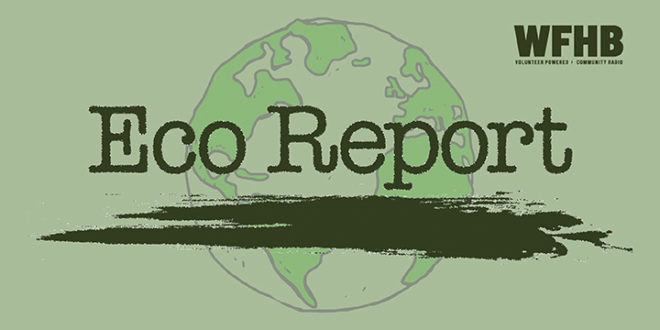Podcast: Play in new window | Download (Duration: 30:22 — 41.8MB)
Subscribe: RSS
| Hello and welcome to Eco Report. For WFHB I’m Julianna Dailey. And I’m Cynthia Roberts. Later in the program, Environmental Correspondent Zyro Roze speaks with a homesteader and sustainability educator from Spencer, Indiana about her life journey in academia and as a nature lover from a young age. |
|
And now for your environmental reports: The New York Times reports that the United States and the state of California have reached an agreement with the truck engine manufacturer Cummins. The agreement is on a $1.6 billion penalty to settle claims that the company violated the Clean Air Act by installing devices to defeat emissions controls on hundreds of thousands of engines, the Justice Department announced last Friday. The penalty would be the largest ever under the Clean Air Act and the second largest ever environmental penalty in the United States. Defeat devices are parts or software that bypass, defeat or render inoperative emissions controls like pollution sensors and onboard computers. They allow vehicles to pass emissions inspections while still emitting high levels of smog-causing pollutants such as nitrogen oxide, which is linked to asthma and other respiratory illnesses. The Justice Department has accused the company of installing defeat devices on 630,000 model year 2013 to 2019 RAM 2500 and 3500 pickup truck engines. The company is also alleged to have secretly installed auxiliary emission control devices on 330,000 model year 2019 to 2023 RAM 2500 and 3500 pickup truck engines. “Violations of our environmental laws have a tangible impact. They inflict real harm on people in communities across the country,” Attorney General Merrick Garland said in a statement. “This historic agreement should make clear that the Justice Department will be aggressive in its efforts to hold accountable those who seek to profit at the expense of people’s health and safety.” —Norm Holy |
| Indiana has over 2,300 megawatts of wind capacity and is 12th in the U.S. for the number of wind turbines, which is 1,264. In 2019, wind generated 6% of electricity in Indiana. Over 1,100 MW of new wind projects are in development or construction. Wind power in 2023 now accounts for 9 percent of electric power in Indiana.
With gusts from Lake Michigan and a strategic position between two electric grids, Indiana is one of the best states in the country for building wind turbines, experts say. And as a result, the industry is growing. Wind energy also brings considerable economic growth to the states and localities that host projects. Total wind energy investment in Indiana to date is over $6.8 billion. American Clean Power also estimates annual state and local tax payments of $23.4 million and annual land lease payments of $22 million. Typically new construction yields about five thousand dollars per year per wind turbine to the land owner. Southern Indiana is not a great place for wind turbines because there isn’t enough wind. —Norm Holy |
| Climatewire reported that Minnesota Democrats, newly in control of the state government, began 2023 by enacting a clean electricity standard. Michigan lawmakers followed suit months later — as one of their final acts before gaveling out for the year.
The two laws were bookends to a year of climate action, experts say, as Democratic state officials advanced major policies that climate hawks could once only dream of. State officials committed serious money and political capital to cleaning up the electricity sector — the backbone of the energy transition — while also boosting electric vehicles, restricting gas in new buildings, and building factories to manufacture batteries and other clean technology. Climate activists hope such actions ripple out nationwide, as the U.S. lags in its goal of halving emissions by 2030. The best we can say for Indiana is that the state verified its “coal forever” stance. —Norm Holy |
| The New York Times reports this past summer was the Arctic’s warmest on record, as it was at lower latitudes. But above the Arctic Circle, temperatures are rising four times as fast as they are elsewhere. The past year overall was the sixth-warmest year the Arctic had experienced since reliable records began in 1900, according to the 18th annual assessment of the region, published by the National Oceanic and Atmospheric Administration.
The hottest spots on the Arctic map varied throughout the year. At the beginning of the year, temperatures over the Barents Sea north of Norway and Russia were as much as 5 degrees Celsius, or 9 degrees Fahrenheit, above the 1991-2020 average. In the spring, temperatures were also about 5 degrees Celsius hotter than average in northwest Canada. Hotter air temperatures dry out vegetation and soil, priming the pump for wildfires to burn more easily. This year, during Canada’s worst wildfire season on record, fires burned more than 10 million acres in the Northwest Territories. More than two-thirds of the territories’ population of 46,000 people had to be evacuated at various points and smoke from the fires reached millions more people, reducing air quality as far as the southern United States. This year, for the first time, the Arctic Report Card includes weather and climate observations from the Alaska Arctic Observatory and Knowledge Hub, a network of Iñupiat observers living on Alaska’s coast. The observers reported that multiple powerful storms hit their communities last year. A lack of sea ice exposed the coast — including roads, buildings, community ice cellars and historic landmarks — to more damage from flooding and erosion. —Norm Holy |
| And now, Part One of a conversation between Zyro Roze and Aliyah Keuthan (pronounced Koothan), a sustainability educator and homesteader from Owen County, about her formative years, education and passion for environmental and social justice.
|
| For Eco Report, I am Julianna Dailey. And, I am Cynthia Roberts. Are you looking for a way to make a difference on environmental issues? Here at Eco Report we are currently looking for reporters, engineers, and segment producers. Our goal is to report facts on how we’re all affected by global climate disruption and the ongoing assaults on our air, land and water. We also celebrate ecologists, tree huggers, soil builders and an assortment of champions who actively protect and restore our natural world, particularly those who are active in south central Indiana.
All levels of experience and all ages are welcome, and we provide the training you’ll need. WFHB also offers internships. To volunteer for Eco Report, give us a call at (812) 323-1200, or e-mail us at: [email protected]. |
|
And now for some upcoming events: Brown County State Park will have their First Winter Hike Series for 2024 to Kelp Village on Saturday, January 6th, from 11 am to 1 pm. You will explore the old village where you will see foundations of old buildings, home sites and more. The hike is about 1.5 Round Trip miles. Dress for the weather and meet at the Nature Center. |
| Join the Sycamore Land Trust for a First Week Hike to the Beanblossom Bottoms Nature Preserve on Sunday, January 7th, from 1 to 3 pm. Registration is required at the Sycamore Land Trust Website. |
| Enjoy a Winter Exploration Hike at the Southfork Robertson Cemetery area at Monroe Lake on Wednesday, January 10th, from 1:30 to 3:30 pm. This is an off-trail hike through lesser-known areas of Monroe Lake. There is no “set” path and no toilet facilities. Sign up at bit.ly/weh-jan10-2024. |
| The Whooper Wednesdays will continue at Goose Pond Fish and Wildlife Area until February 21st. Come to the Visitors Center on Wednesday, January 10th, at 8 am to walk the property and see if you can spot some of the resident birds, including the endangered Whooping Crane. Make sure to dress for the weather. |
| The Brown County State Park Winter Hike Series starts off the new year with The Boulder in the Tree Hike on Saturday, January 13th, from 11 am to 1 pm. This is your chance to see the boulder in the tree and try to figure out how it got there. Boots are essential for this hike. |
| And that wraps up our show for this week. Eco Report is brought to you in part by M-P-I Solar, a Bloomington business specializing in solar hot water, solar electricity and solar hot air systems. M-P-I Solar designs and installs solar power generation systems that encourage independence and individual responsibility. Found locally at 812-334-4003 and on the Web at mpisolarenergy.com. |
| This week’s headlines were written by Norm Holy. Today’s news feature was produced by Kade Young and Noelle Herhusky-Schneider. Julianna Dailey assembled the script which was edited by Zyro Roze. Julianna Dailey compiled our events calendar. Kade Young and Noelle Herhusky-Schneider produced today’s show. Branden Blewett is our engineer. |
| For WFHB, I’m Julianna Dailey. And I am Cynthia Roberts. And this is Eco Report. Thank you for listening. |
 WFHB Bloomington Community Radio
WFHB Bloomington Community Radio



